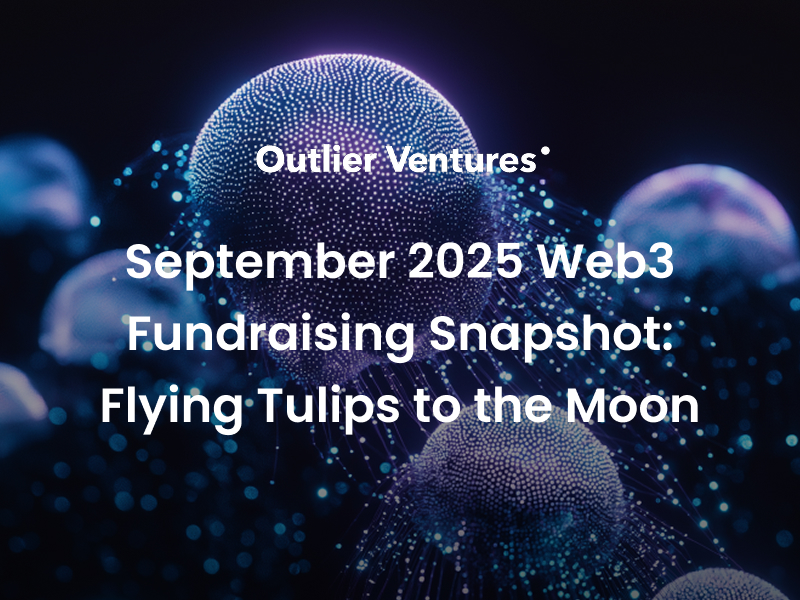Proving there is a market for your idea is a crucial aspect of building a sustainable business – especially when it comes to raising funding. Haya al Husry, Program Manager at Outlier Ventures, shares her insights on why traction matters, how to go about demonstrating it, and what matters to investors when it comes to validating the market need for your idea.
Traction refers to the progress of a startup and its overall momentum, and it is an essential factor for potential investors. This is because the number one reason startups fail is due to misinterpreting market demand, with over a third of new ventures reporting this as their main cause of death. In the current climate, VCs are a lot more particular, and are hungry to see proof of market need.
The hard truth is that up to 90 per cent of startups fail. In order to gauge whether a venture is likely to succeed, there are two key questions we ask at Outlier Ventures when it comes to traction. The first is: who else cares about the idea besides the founding team? The second question is: can this team pull it off? While intelligent people can have strong ideas, there is often a vast gap between theory and execution.
This is where traction comes in. Early traction is tangible proof that your customers are interested in what you’re building and that you can convert and attract those customers to your company. However, it’s important to remember that early traction is more challenging to understand. Once a business is running, measuring its momentum becomes simpler, with metrics such as revenue numbers. Pre-revenue, searching for traction is about finding specific indicators or signals.
Key ways to demonstrate traction
Traction indicators or signals differ according to the market or type of business. When it comes to B2B signals, there are three ways to demonstrate momentum to investors. Each of these indicators show an investor or stakeholder that there are people interested in seeing the venture go from an idea to a reality.
While there are more indicators than these, some of the most typical yet powerful signals are as follows:
- There is domain expert willing to act as an advisor, keen to invest time and money into the startup because they see potential;
- There is a letter of intent from a potential customer or a client, indicating that they plan to purchase or work with the venture when feasible;
- There is a pilot being run with a potential customer, showing that the market need is already visible and urgent enough to justify an initial trial.
If none of the above are possible or feasible, then there are other ways to demonstrate that an idea has legs. For example, it can help to have deep expertise when it comes to the prospective customer or client base. It helps founders if they can demonstrate their personal experience in a particular domain or a network – if not, getting advisors from the industry can also help. In fact, if a founding team doesn’t have relevant expertise, then getting a strong advisor with domain expertise is essential and a very relevant signal to investors.
Since founders typically require two to three times longer than expected to validate a business model, more momentum means a shorter path to becoming profitable. For this reason, a key question that investors are trying to answer is: can this team close an account with big customers, or not? This needs to be demonstrated through action, especially when it comes to B2B businesses.
For B2C businesses, a strong method of measuring traction is running a small beta test of users or building a community interested in following the venture and its progress. The more competition a startup has, the more critical it is to demonstrate traction as a differentiator. A start-up without competition, needs to focus on concept validation, while start-ups with more competition need to show more tangible traction and early users.
What matters to investors around traction?
Besides demonstrating an obvious market need and a clear path to profitability, the key reason investors care about traction is that they are not the target market for all the business ideas that get presented. For example, we were recently pitched by a founder who wanted to work with musicians. Since we are not musicians, we could not judge whether it was a necessary idea or not – we needed validation or proof that there would be an audience.
For this reason, we indicated that the founder would need at least 20 musicians onboarded onto the platform. As it turned out, there were not enough artists who came on board and without this validation, we could not justify backing the concept. After all, while it can sound defeatist, a flawed business model is the reason why almost a fifth of new businesses do not survive, and the main way to predict against this is to see the market need in action.
To give another example, we were recently pitched by a company in regenerative finance who demonstrated a lot more traction. This particular startup received letters of intent from various corporate clients and could point to many initiatives they ran between the first and the second time they applied. Seeing the enthusiasm of others can be enough to give investors confidence in the product.
This is why having an engaged community is benefical, especially when looking for investment. If you have a B2C company, an engaged community can be a good way to demonstrate traction. Sometimes, even sign-up sheets can go a long way and provide start-ups with an initial list of potential beta testers. While a startup may have the world’s greatest product, if nobody is interested in it; if nobody hears about it and if there is no existing beta community or early adopters, then it can be really difficult for progress to build.
The best time to approach investors
A company who is at “too early” a stage may not benefit from going through our base camp, because they might not yet understand what they wish to gain from it. The best time to approach inventors is when you already have a clear and demonstrable knowledge of who you are selling to – this is the best time that you can then leverage investors networks.
Furthermore, Outlier Ventures is a very fast-paced program. We give you access to in-house experts that have helped launched 100+ startups and multiple billion dollar networks. In short, there is a lot happening in the three months that we work with a startup, without much time allocated to determine if there is a product-market fit.
However, a caveat to that is many if not most founders will pivot while in the program. It is 100% okay, and encouraged, to say “look, this product could be more sticky if we sold it in this way or developed this feature more.” Yet there should already be a firm grasp of how what you are developing addresses a need in the market.
In other words, before you approach investors like Outlier Ventures, the base should already be there. There should already be some sort of indication that even if the product is not in its best form, there is already some sort of validated product-market fit. Ideally we want to take you from one customer to five, instead of spending the three months potentially getting to one customer.
This means that founding teams on the journey to that product-market fit should bear in mind that traction is not a ‘nice to have’ for most investors – at this stage, it is a must-have. In the long run, traction helps you to gauge whether or not the idea fills a real market need. While it is so easy to get caught up in the excitement of an idea’s potential, execution is everything, and it starts with executing on the discovery and demonstration of early-stage traction.
We often get founders stuck in the cycle of, “I need funding but I can’t get funding until I have traction, and I can’t get traction until I get funding”. A lot of the solutions I have suggested are ways of getting early traction without a large amount of funding required – these indicators can often get the first-believers on board.
The final thing is that it comes to building a product without much money to demonstrate your skills – one way is by having a barebones MVP (this is especially effective when a product is not highly technical). When a product is highly technical, it is very important to have a capable and experienced CTO, which shows investors that even though the product isn’t built right now, it could be built in the future.
In this piece, you’ve learned about how to demonstrate a market need. Here are our top tips:
- Early traction is tangible proof that your customers are interested in what you’re building and that you can convert and attract those customers to your company.
- Having an engaged community is benefical, especially when looking for investment.
- If a founding team doesn’t have relevant expertise, then getting a strong advisor with domain expertise is essential and a very relevant signal to investors.
Further reading:
- Traction: How Any Startup Can Achieve Explosive Customer Growth by Gabriel Weinberg



